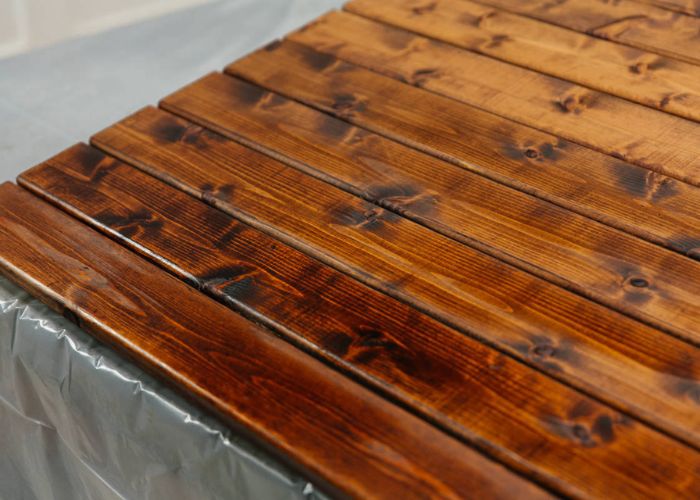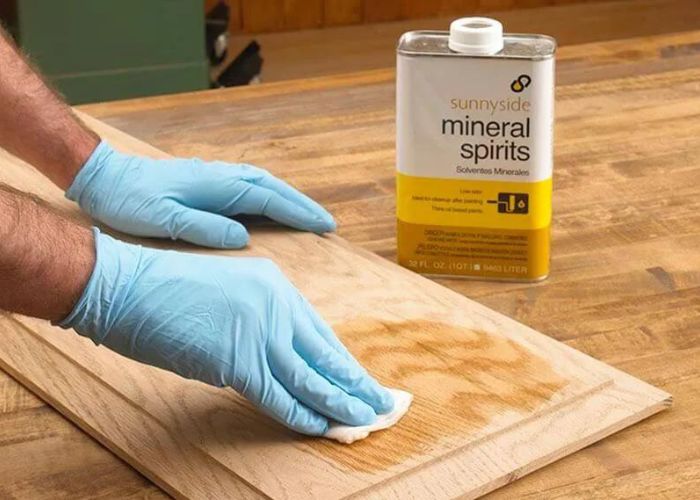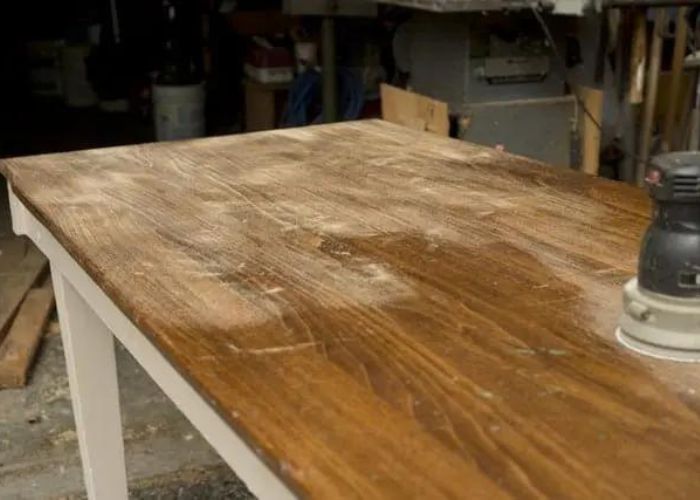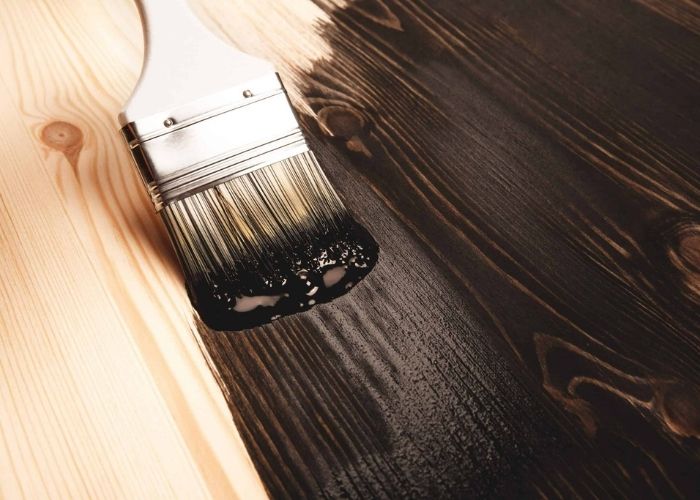When applying a wood stain, you need to let it sit on the surface enough to color it, but wipe it off before it dries. Leaving the stain on without wiping the excess will result in too much strain on wood and a sticky mess that never dries.
Whether you let wood stain stay on for too long before wiping or forgot to wipe off excess stain altogether, you must fix the problem to achieve the desired outcome.
This write-up examines what happens if you leave the dark stain on wood without wiping the excess and what to do in such circumstances.
How to Remove Excess Stain from Wood
Use mineral spirit or denatured alcohol. Both will clean up any remaining stain residue effectively and safely. If you don’t have either of these, apply more stain in small areas to even out the color. Allow the stain to dry and then finish with a protective sealant, such as polyurethane or lacquer. You can as well sand it down before applying any new stain or sealant. This will ensure that the wood can absorb the product evenly, resulting in an even color and finish.
What Happens if You Forgot to Wipe off Excess Stain?

Wood stain works by penetrating the pores and grain to color the wood. Therefore, whatever remains on the surface must be wiped off for the stained wood to dry properly.
If you do not wipe off the stain or spread it too thickly, it will become sticky and blotchy as the solvents within the stain evaporate.
Usually, you may want to leave the stain on for a few minutes to let it apply the color. As a rule of thumb, the longer the stain stays on the wood, the darker the color you achieve.
However, you don’t want the stain to stay too long that it dries before wiping the excess. Additionally, different stain types take different amounts of time to dry.
How Do You Fix a Stain that wasn’t Wiped?
Unwiped wood stain will be tacky and unlikely to dry by itself. It may also appear blotchy and undesirable. In any case, you can use one of these three methods to remove the sticky material from the wood surface.
Option 1: Use mineral spirits

For a small project, the easiest solution is to wipe the surface with a cloth dampened with some mineral spirits. The spirits effectively dissolve the tacky pigments without affecting the stained wood surface.
The dissolved pigments should come off the wood as you wipe, leaving only the colorant that seeped into the wood grain.
Read also: Is mineral spirits the same as mineral oil?
Option 2: Apply more of the stain
This alternative might sound counterintuitive, but it does the job. Adding more of the stain to the sticky surface will supply the pigments with the solvent they lost due to evaporation.
As a result, the stain will become wet again, so you can remove the excess by wiping it off with a cloth. Eventually, you can smooth out the finish and achieve your desired look.
Option 3: Sand it down

Sanding is an option where you don’t intend to retain the stain job and instead do the entire project afresh. In that case, use low grit sandpaper to sand away the sticky layer of stain.
You may have to use more than one sandpaper depending on the thickness of the layer or the size of the stained surface.
After removing the whole sticky part, you may need to switch to higher grit sandpaper to finalize the sanding. One way is to increase the grain size gradually until you reach 240.
After sanding away the stain and smoothening the surface, you can reapply it correctly.
Also Read: How to Clean Wood Stain Off Concrete
How to Remove Sticky Stain from Wood – step by step
The wood stain becomes tacky on a surface as the solvent evaporates. Eventually, the pigments remain without a binder, which causes stickiness.
To remove the sticky stain, you need to introduce a binder or solvent that will soften it and allow you to wipe it away easily. This wiping should leave the stained surface smooth and dry.
Ideally, you don’t want to use a solvent to affect the colorant already absorbed into the wood grain. That’s why more of the same wood stain or mineral spirits are recommended for this role.
Mineral spirits are gentle and will dissolve only the stain and not affect the wood.
What you will need
- Lint-free rag or stain cloth
- Mineral spirits (or the same stain as on the tacky surface)
- Your preferred finish
- Applicator such as a high quality bristled brush
- Steel wool
- Rubber gloves
- Eye protection
- Respirator (optional)
- Tarp (optional)
Procedure to follow
If you forgot to wipe off the excess stain and now want to fix the problem, you can do it in these few simple steps.
Step 1: Protect yourself and prepare the workspace
Once you have assembled all the supplies you need for the task, wear a pair of rubber gloves and eye protection. Since you will be working with chemicals, it’s recommended that you protect your eyes and sin accordingly.
Whether you opt to use more stain or mineral spirits, the rubber gloves will come in handy, protecting your skin from getting stained. But incase you stain your hands accidentally, here’s how to get stain off your hands.
If you are sensitive to the fumes or scent of mineral spirits, consider wearing a respirator for your protection.
You may also want to cover the objects around your workspace or the hardwood floor with a drop cloth or plastic sheeting to avoid staining them.
Step 2: Soften the excess stain
Start by saturating a lint-free rag or damp cloth with mineral spirits and applying the solvent onto the sticky surface. We recommend working in small areas at a time for the best results.
If you work in large areas, you could soak more than you can wipe before the stain dries again. So, focus on cleaning one small section at a time until you finish the project.
More importantly, keep saturating the cloth with the mineral spirits from time to time while you work to ensure it’s soaked throughout the exercise.
The soft cloth will transfer the mineral spirits to the wood surface, softening the tacky pigments and loosening them to come off.
The alternative way to soften the sticky wood stain is to apply another heavy coat of stain such as Minwax oil-based stain using a rag and let the stain sit on for about 5 minutes.
Either of these products will dissolve the stain and make it easy to lift off the wood surface. Just ensure you use an oil stain if the previous one was oil-based and a water-based stain if you used water-based stains initially. Read more on removing oil-based stain from wood.
Step 3: Wipe away the excess stain
Once the surface has been adequately soaked, wipe it off with a rag just as you would when applying a fresh coat of stain.
The excess stain should come off the wood surface as you wipe, leaving its surface smooth but adequately colored.
If you’re working on a large project, the systematic way to complete the work is to wipe one section as you soak the next and continue that way until you cover the entire surface.
And, ensure you wipe until you achieve the desired stain color on your wood. You should know the job is done when the surface looks evenly stained and smooth.
By the way, if you’re dealing with unfinished wood marred by water stains, here’s a comprehensive guide on how to remove water stains from unfinished wood.
Step 4: Let the stained surface dry
Let it dry properly when you have the stain to the color you want. The drying time will vary depending on the specific stain you have used, so ensure you follow the manufacturer’s recommended drying time.
For example, you can expect a longer drying time for an oil-based stain and a shorter time for water-based wood stains.
Most stains will need at least a day to dry completely. So, give the cleaned surface about 24 hours before proceeding to the next step.
Related Post: How Long Does Stain Take to Dry Before Rain
Step 5: Apply a protective wood finish
A clear coat is essential for ensuring the longevity and durability of a stained wood surface. Ensure you clear coat the wood once the stain has dried to lock in the color and preserve it for longer.
Whether you use polyurethane, fast-drying polyurethane varnish, or some other film-forming finish, ensure you follow the manufacturer’s instructions for the best results.
What do you do with the excess stain? Here’s a guide on wood stain disposal to help you out.
Do You Have to Wipe off Wood Stain?
After applying the stain, wiping off the excess is a basic rule for getting the desired results. You want to apply a generous coat of your chosen wood stain and wipe off the excess before it dries to create a smooth, even color.
Leaving the stain on the wood without wiping it will create a sticky, blotchy finish that never dries. As a result, it can double your work as you will eventually have to redo the work to get the desired outcome.
Read Also: What Happens if you Stain over Stain?
How to Wipe the Stain off Wood
To wipe the stain off the wood, use a clean, lint-free cloth and run it in one direction along the wood grain. This will help hide any lines left from wiping by aligning them with the grain.
In addition, using a lint-free cloth helps ensure that no particles remain on the stained piece.
Interesting Post: What Happens If You Use Old Stain?
FAQs
Can you leave the stain on without wiping?
Yes, you can leave wood stain such as Minwax penetrating stain on without wiping it off to create a rich shade of the stain on your wood. However, this is only viable if you apply a thin, even coat. If the coat is heavy and thick, it will take longer to dry and allow a topcoat. Unless you use a gel stain, the unwiped stain may never dry, which can be messy. Wiping is essential for all penetrating wood stains.
Can you use mineral spirits to remove the excess stain?
Yes, mineral spirits are one of the most recommended solvents for removing all the excess stain that has become tacky. You could also use lacquer thinner, but this isn’t as gentle as mineral spirits. When using mineral spirits to clean wood, use a lint-free cloth to apply the spirits and scrub vigorously to dissolve and lift off the dry stain, creating a smooth and dry piece.
How long to leave a wood stain on?
When staining a wood or wooden furniture, wipe the stain off immediately if you want a lighter tone. However, if you prefer a darker stain color, leave the stain on the surface for 5 to 10 minutes before wiping it off.
Will tacky stain eventually dry?
No, the sticky pigment that remains if you apply excess stain never dries no matter how long you wait. So, it is crucial to wipe off any excess product within a maximum of 5 to 10 minutes. Otherwise, the solvents will evaporate and leave a sticky mess. If you attempt to wipe the excess too late, consider using additional fresh stain or mineral spirits to fix the problem, following the instructions in this guide.
Conclusion
Forgetting to wipe off excess stain is a temporary mistake; you can fix the bad stain job with the right tools.
Following these steps will help you to successfully remove excess stain from your wood surfaces without damaging them in the process. Remember, always use a protective covering such as gloves when working with any type of stain.
So next time you have a tacky stained wood surface, consider using the procedure in this guide to correct the mess and do the job correctly.
Please leave any thoughts or comments in the comments section.


I just stained a sanded wood table top with oil based stain. In the hot sun it dried quickly and even though I wiped it off with a cloth the wood is mostly black. Will mineral spirits help the situation even if it’s been hours since it dried?
My plan for now is to sand lightly and possibly and start again.
Sure, that would work.
I was with painting so I hired a painter and I liked what he did with painting. Then I had him stain my old woodwork around windows and doors in living room dining room and hall. However the stain became a sticky mess he did not wipe off the stain, he just put it on with a brush. So I have been trying to rectify this mess, first I use mineral spirits which worked little. then I tried using stain clear stain rather than the original color and that seemed to make it a lot better but there’s still some sticky areas. Do I just wait again and reapply?
Give it 30 days to cure.
Were they sanded first? Sounds like he used gel stain and went right over top of everything that was there from your description.
If you do not wipe off the stain or spread it too thickly, it will become sticky and blotchy as the solvents within the stain evaporate. Plus all gel stains need a top coat of sealer, such as polyacrylic or polyurethane. Wait time is 24-72 hours to ensure the stain is dry before top coating.
Also, temperature is EXTREMELY important with drying stain. If it’s humid, it’s going to take a lot longer than 24 hours…gel stain (although stain) is like a paint and would remain sticky until dried.
I stained my cabinets for the first time with a gel stain. I made the mistake of painting the stain on. I tried wiping it off but the whole thing would come off. Hours later, it’s sticky. Do you think it’ll dry or should I use the mineral spirits?
It will dry eventually. Other thing to do is apply more coats to make it darker. Put another thinned coat of stain on and wipe off immediately.
The stain is dry and not sticky but too glossy (shiny) how to I remove the sheen? This was a repair and is more shiny than the undamaged area
Lightly scuff with steel wool